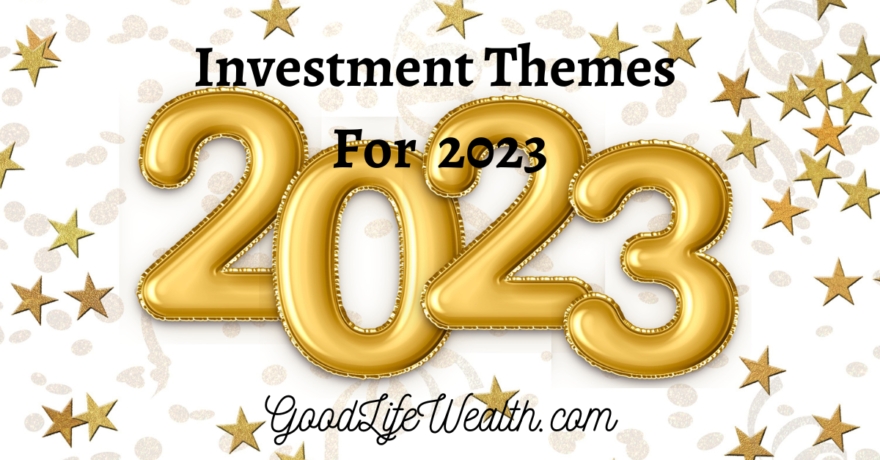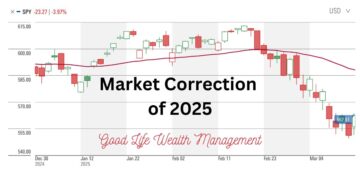At the start of each year, I discuss our investment themes for the year ahead. Today we share our Investment Themes for 2023. 2022 was a lousy year for investors, with a Bear Market in stocks (a loss of more than 20%) and double digit losses in bonds. And to add insult to injury, 9% inflation increased our cost of living even as portfolios shrank. War in Europe, supply chain problems, and political drama added to the uncertainty.
The Federal Reserve is committed to raising interest rates to slow the economy back down to 2% inflation. Economists are predicting a recession in 2023. With all these problems, it is easy to feel pessimistic about 2023 as an investor.
However, there are reasons for optimism. The call for a recession is so clear that it may already be somewhat priced into the market’s expectations for 2023. Many stocks are down 20%, 30% or more from their peaks and more fairly valued today. The large losses in international stocks were driven by a 17-20% increase in the value of the dollar to the Euro and Yen, and that headwind may be turning into a tailwind as the dollar starts to decline.
Today, we have very attractive rates in the bond market, 4.5% on short-term bonds and 5.5% on intermediate investment grade bonds. Bonds look better in 2023 than they have since the Global Financial Crisis in 2008.
My annual investment themes are not a prediction of whether stocks will be up or down this year. We don’t believe anyone can time the market or predict short-term performance. Instead, our process is to tilt towards the areas of relative value, with a diversified, buy and hold portfolio. Here is how we are positioning for the year ahead.
(And if you want to look back, here were our Investment Themes for 2022 and 2021.)
Stocks
In 2022, the Growth / Value reversal became widely acknowledged. For over a decade, growth stocks had crushed value stocks, but that leadership came to an end last year. Now, value stocks are performing better and growth stocks could have further to fall. We are using Value funds across markets caps – large, medium, and small.
International stocks have lagged US stocks, but today offer a better value. These stocks are cheaper than US stocks, have a higher dividend yield, and offer a hedge against a falling dollar. International and Emerging Markets are attractive today, and we are maintaining our international diversification. There are now more low-cost Value funds and ETFs offered in International stocks, and so we have replaced some of our Index Funds with a Value fund.
Overall, we have not made significant changes to the holdings within our stock allocations. What has changed is the expected return of stocks versus bonds. Over the next 10 years, Vanguard has an expected return of 5.7% return on US stocks. Yields have risen in A-rated bonds to where we can get a similar return from bonds. So, we are moving 10% of our stock allocation into individual bonds, 5-7 years with a yield to maturity of at least 5.5%. We are buying AAA government agency bonds (such as Fannie Mae or Freddie Mac), and some A-rated corporate bonds. These are offering a similar return as the expected return from stocks, but with much, much less risk and volatility. We aren’t giving up on stocks, but if bonds are going to offer similar potential, then we are going to add to bonds.
Bonds
Our core approach to bonds is to buy individual A-rated bonds, laddered from 1-5 years. We buy Treasury Bonds, Agency Bonds, CDs, Corporate Bonds, and Municipal Bonds. Yields are up and we want to lock-in today’s yields. For clients who are retired or close to retirement, our laddered bond portfolio will be used to meet their income needs for the next five years.
We use a “Core and Satellite” approach. The 1-5 year ladder represents our Core holdings today. For 2023, we decreased our Satellite holdings in bonds. Last year, we had a large position in Floating Rate Bonds. And these ended up being the best performing, most defensive category within Fixed Income in 2022. They worked exactly as hoped, protecting us during a year of rising interest rates. For the year ahead, though, they are less attractive. These are smaller, more leveraged companies. A year ago, their debt cost them 3%. Today, those companies are facing a recession and their debt now may cost them 7%. Floating Rate bonds have become more risky and more likely to have losses. We have sold Floating Rate and added the proceeds to our core 1-5 year ladder.
At the start of 2022, our focus was to minimize interest rate risk by keeping bonds short-duration. Yields have risen so much that in 2023 we want to extend duration and lock-in higher yields. Unfortunately, with an inverted yield curve, it is more challenging. Still, today, we are looking to add 5-7 year bonds to our ladders when cash is available and we can find attractive bonds.
We continue to own a small position in Emerging Market bonds. These have always been more volatile than other bonds, but history suggests that selling after a down year is a bad idea. The yields going forward are attractive, and many of these emerging countries are actually more fiscally sound than developed nations.
Alternatives
We are always looking for other investments which offer a unique opportunity for the current environment. We want returns better than bonds, but with less risk than stocks. If we can add investments with a low correlation to stocks, it will improve the risk/reward profile of our portfolio.
We purchased commodities early in 2022 with inflation spiking. Although they had a good Q1, commodities fared poorly for the rest of the year. We sold most of our commodities in October, and replaced them with TIPS, Treasury Inflation Protected Securities. The price of TIPS fell dramatically through the year, and by October, we could buy 5-year TIPS which yield 1.7% over inflation. TIPS are now a more direct inflation-hedge than commodities, which are frustratingly inconsistent. (If Gold doesn’t do well when there is 9% inflation, when will it shine?) Today, TIPS also offer a better yield than I-series US Savings Bonds.
Preferred Stocks were down in 2022 and we are trimming those positions to add to our Core 1-5 Year Ladder. Still, there are some good opportunities as many Preferreds are now trading at a 30% discount to their $25 par value. Preferreds with a set maturity date should be held to maturity. Perpetual Preferreds (those without a maturity) now offer 6-7% current yields or higher. While volatile, that is a decent level of income, plus the potential for price appreciation if interest rates fall in the future.
Overall, Alternatives are less attractive in 2023 because we now have such compelling bond yields. When we can buy risk-free T-Bills with a 4.5% yield, there is a higher bar for what will make the cut as an Alternative.
Summary
No one has a crystal ball for the year ahead, and our Investment Themes for 2023 are not based on a 12-month horizon. Instead, we are looking for assets that we think will be good over the next 5-10 years. We remain very well diversified, both in size (large, medium, small) and location (US, International, Emerging), as well as in Bonds and Alternatives. We diversify holdings broadly, with 10-12 ETFs, and each fund holding several hundred to several thousand stocks.
Although 2022 was an ugly year for investors, I wouldn’t bet against the stock market after a 20% drop. Historically, the market is usually up 12 months later. The expectations for 2023 are low and I would certainly caution investors to assume a volatile year ahead. Still, in these difficult periods, the best thing for investors is to stick to a good plan: diversify, keep costs and taxes low, and don’t try to time the market.
We take a patient approach and tilt towards the attractive areas, including Value stocks and International. Bonds finally offer a decent yield today and we have increased our core bond holdings and are looking to extend duration. We are making more changes in the bonds and alternatives than to our stock holdings. In 2022, we added more value on the bond side of portfolios, relative to benchmarks, than we did in stocks. So, as boring as bonds may seem, we focus a lot on bonds because we think there is an opportunity to add value for our investors.
Investing isn’t easy, but thankfully, it can be simple. We don’t need a lot of complexity to accomplish our goals over time. Years like 2022 are an unfortunate reality of being an investor. For 2023, we are making small adjustments but focused on staying the course.







